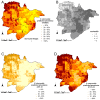High prevalence and spatial distribution of Strongyloides stercoralis in rural Cambodia
- PMID: 24921627
- PMCID: PMC4055527
- DOI: 10.1371/journal.pntd.0002854
High prevalence and spatial distribution of Strongyloides stercoralis in rural Cambodia
Abstract
Background: The threadworm, Strongyloides stercoralis, endemic in tropical and temperate climates, is a neglected tropical disease. Its diagnosis requires specific methods, and accurate information on its geographic distribution and global burden are lacking. We predicted prevalence, using Bayesian geostatistical modeling, and determined risk factors in northern Cambodia.
Methods: From February to June 2010, we performed a cross-sectional study among 2,396 participants from 60 villages in Preah Vihear Province, northern Cambodia. Two stool specimens per participant were examined using Koga agar plate culture and the Baermann method for detecting S. stercoralis infection. Environmental data was linked to parasitological and questionnaire data by location. Bayesian mixed logistic models were used to explore the spatial correlation of S. stercoralis infection risk. Bayesian Kriging was employed to predict risk at non-surveyed locations.
Principal findings: Of the 2,396 participants, 44.7% were infected with S. stercoralis. Of 1,071 strongyloidiasis cases, 339 (31.6%) were among schoolchildren and 425 (39.7%) were found in individuals under 16 years. The incidence of S. stercoralis infection statistically increased with age. Infection among male participants was significantly higher than among females (OR: 1.7; 95% CI: 1.4-2.0; P<0.001). Participants who defecated in latrines were infected significantly less than those who did not (OR: 0.6; 95% CI: 0.4-0.8; P=0.001). Strongyloidiasis cases would be reduced by 39% if all participants defecated in latrines. Incidence of S. stercoralis infections did not show a strong tendency toward spatial clustering in this province. The risk of infection significantly decreased with increasing rainfall and soil organic carbon content, and increased in areas with rice fields.
Conclusions/significance: Prevalence of S. stercoralis in rural Cambodia is very high and school-aged children and adults over 45 years were the most at risk for infection. Lack of access to adequate treatment for chronic uncomplicated strongyloidiasis is an urgent issue in Cambodia. We would expect to see similar prevalence rates elsewhere in Southeast Asia and other tropical resource poor countries.
Conflict of interest statement
The authors have declared that no competing interests exist.
Figures



References
-
- Olsen A, van Lieshout L, Marti H, Polderman T, Polman K, et al. (2009) Strongyloidiasis—the most neglected of the neglected tropical diseases? Trans R Soc Trop Med Hyg 103: 967–972. - PubMed
-
- Marcos LA, Terashima A, Dupont HL, Gotuzzo E (2008) Strongyloides hyperinfection syndrome: an emerging global infectious disease. Trans R Soc Trop Med Hyg 102: 314–318. - PubMed
-
- Foreman EB, Abraham PJ, Garland JL (2006) Not your typical Strongyloides infection: a literature review and case study. Southern Medical Journal 99: 847–852. - PubMed
Publication types
MeSH terms
LinkOut - more resources
Full Text Sources
Other Literature Sources

